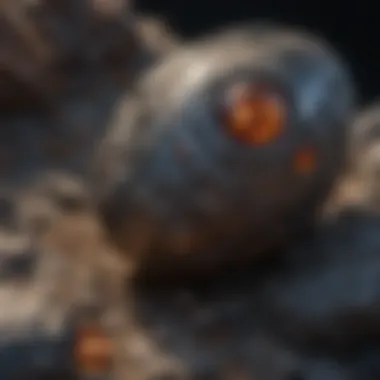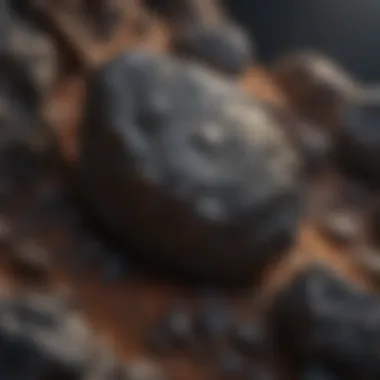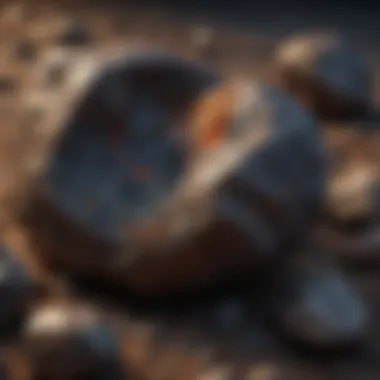Unveiling the Geological Treasures: Exploring the Intrinsic Value of Meteorite Rocks


Rock and Fossil Identification
When it comes to meteorite rocks, their identification is a crucial aspect for collectors and enthusiasts. Understanding the types of rocks and fossils, the characteristics to look for, as well as the tools needed for identification, forms the foundation of distinguishing these geological treasures. Meteorite rocks come in various types, ranging from stony to iron and stony-iron compositions. The key characteristics to look for include the presence of fusion crust, regmaglypts, and Widmanstätten patterns, which offer valuable clues to their extraterrestrial origin. Utilizing tools such as magnetometers, microscopes, and acid tests can aid in further narrowing down the identification process, ensuring authenticity and value in collections.
Collecting Tips and Techniques
Collecting meteorite rocks requires a blend of passion and precision. Best practices include conducting thorough research on known impact sites and collaborating with experienced collectors for guidance. Locating prime collecting sites involves exploring regions with a history of meteorite falls or impact craters. Safely extracting specimens demands careful handling to prevent contamination or damage. Utilizing metal detectors, grid searching, and visual inspection techniques can enhance the success of meteorite hunting expeditions, adding to the thrill of discovery.
Preservation and Display
Preserving meteorite rocks is essential to maintain their integrity and value over time. Techniques such as cleaning with mild solvents, storing in a dry environment, and avoiding exposure to moisture or direct sunlight can prolong the lifespan of these geological wonders. Proper storage methods include utilizing acid-free containers, silica gel packets for moisture control, and protective casing to prevent scratches or tarnishing. When it comes to display, collectors can get creative by showcasing meteorite rocks in shadow boxes, LED-lit stands, or custom mounts that highlight their unique features, serving as conversation pieces and educational displays.
Geological Insights
Exploring the geological insights offered by meteorite rocks unveils a realm of scientific intrigue and historical significance. These celestial specimens provide valuable clues to the formation of our solar system, shedding light on processes that date back billions of years. By studying their composition, isotopic signatures, and mineralogy, researchers can unravel the mysteries of cosmic evolution and planetary dynamics. Notable discoveries in the field, such as finding meteorites with rare isotope compositions or studying impact structures for clues about past cataclysmic events, deepen our understanding of Earth's history and the interplay between celestial bodies.
Introduction
In the vast expanse of the cosmos, meteorite rocks hold a mysterious allure that has captivated humanity for centuries. This introductory section sets the stage for an in-depth exploration of the intrinsic value of meteorite rocks – geological treasures that transcend mere earthly bounds. By delving into their composition, history, and significance, we uncover the profound impact these celestial visitors have had on science, culture, and the human imagination. From their meteoric origins to their terrestrial discoveries, meteorite rocks stand as windows into the deep reaches of space, beckoning collectors and enthusiasts to unravel their enigmatic stories.
Understanding Meteorite Rocks
Classification and Types
Within the realm of meteorite rocks, the classification and types play a pivotal role in deciphering their origins and properties. By categorizing these extraterrestrial specimens based on their composition, structure, and meteoritic processes, scientists and collectors alike gain crucial insights into the cosmic events that shaped them. The assorted classes, ranging from stony meteorites to iron meteorites, each boast distinct characteristics that offer a tapestry of narratives about their celestial journeys. Understanding these classifications not only aids in identifying meteorites but also unveils the unique signatures that set them apart in the world of geological wonders, making them sought-after subjects of study.
Composition and Structure
The composition and structure of meteorite rocks serve as the foundation of their scientific and collector's appeal. Composed of elements both common and rare, these cosmic remnants carry isotopic signatures that differentiate them from terrestrial rocks. From chondrules to matrix, meteorites exhibit a mesmerizing array of textures and features that speak to the violent processes that forged them in the depths of space. Exploring their inner structures reveals a fascinating tapestry of minerals and metals, each bearing witness to the fiery journeys these rocks endured before reaching Earth. The composition and structure of meteorites not only shed light on their extraterrestrial origins but also offer valuable insights into the geological processes that have sculpted our universe over millennia.
Historical Significance
Impact on Science and Culture
The impact of meteorite rocks on science and culture transcends their geological value, enriching our understanding of celestial phenomena and ancient belief systems. From the scientific revolutions sparked by meteorite discoveries to the cultural myths and legends inspired by their celestial origins, these rocks have left an indelible mark on human history. By tracing their influence on planetary formation theories, element abundances, and even the potential for extraterrestrial life, meteorites serve as cosmic messengers that bridge the gap between Earth and the stars. Their significance not only fuels scientific inquiry but also sparks artistic inspiration, fostering a deep appreciation for the wonders of the cosmos.
Famous Meteorite Events
Throughout history, meteorite events have punctuated our planet's narrative with moments of awe, terror, and wonder. From the Tunguska event to the Allende meteorite shower, these celestial displays have captured the imaginations of scientists and storytellers alike. Each famous meteorite event carries with it a tale of cosmic collision and terrestrial impact, highlighting the dynamism of our solar system and the enduring mysteries it holds. By exploring these seminal events, we gain a deeper appreciation for the transient yet transformative nature of celestial encounters, underscoring the eternal dance between Earth and the heavens.
The Value of Meteorite Rocks
In this article, the focus shifts towards exploring the intrinsic value of meteorite rocks, shedding light on their significance to collectors, scientists, and enthusiasts. Meteorite rocks stand out due to their exceptional qualities, rarity, and historical context, making them coveted geological treasures. Understanding the value of meteorite rocks encompasses delving into their unique composition, rare isotopic signatures, and impact melt features that set them apart from terrestrial rocks.


Intrinsic Attributes
Unique Composition
The unique composition of meteorite rocks plays a pivotal role in their allure and value. Unlike Earth rocks, meteorite rocks often contain exotic materials not commonly found on our planet, such as various metals and minerals originating from different regions of space. This diverse composition allows scientists to study the origins of our solar system and provides collectors with one-of-a-kind specimens to cherish. Despite their intrinsic value, assessing the composition of meteorite rocks requires sophisticated analysis techniques due to the complex nature of their makeup.
Rare Isotopic Signatures
Rare isotopic signatures found within meteorite rocks offer valuable insights into the processes that shaped our universe. These unique signatures provide clues about the conditions present during the formation of meteorites, offering a glimpse into the early stages of planetary development. Researchers utilize isotopic analysis to trace the origins of meteorite rocks back to their parent bodies, unraveling the mysteries of our cosmic neighborhood. The rarity of these isotopic signatures makes meteorite rocks prized possessions for both scientific research and private collections.
Impact Melt Features
Impact melt features found in some meteorite rocks serve as evidence of their violent history and journey through space. These features result from the intense heat and pressure experienced during meteorite impacts on celestial bodies, leading to the formation of glassy textures and distinctive structures within the rocks. Studying these impact melt features not only provides information about the past collisions but also highlights the resilience of meteorite rocks in withstanding such extreme conditions. Collectors value meteorites with impact melt features for their aesthetic appeal and remarkable backstory, adding to their overall allure.
Commercial and Collectible Value
Delving into the commercial and collectible value of meteorite rocks unveils a dynamic marketplace driven by both scientific interest and collector passion. The increasing market demand and trends for meteorite rocks reflect a growing appreciation for these extraterrestrial gems among enthusiasts and investors. Auctions and sale prices of rare meteorites skyrocket as collectors compete to add extraordinary specimens to their curated collections, showcasing the enduring fascination with these cosmic artifacts. Notable collections around the world exhibit prized meteorite specimens, ranging from historic falls to unique finds, offering a glimpse into the diverse array of meteorite rocks that captivate our imagination.
Market Demand and Trends
The market demand for meteorite rocks continues to rise, fueled by a combination of scientific curiosity and collector's enthusiasm. The fluctuating trends in meteorite sales reflect the evolving interests of buyers, from seasoned collectors seeking rare specimens to newcomers drawn to the mystique of meteorites. Understanding these market dynamics is crucial for individuals looking to invest in meteorite rocks or expand their existing collections, as prices can vary significantly based on factors such as rarity, provenance, and aesthetic appeal.
Auction and Sale Prices
Auctions and sale prices of meteorite rocks serve as a barometer for the value placed on these extraterrestrial treasures within the collecting community. The competitive nature of meteorite auctions often results in record-breaking prices for exceptional specimens, with meteorites fetching top dollar based on their rarity and quality. Collectors keen on acquiring exclusive meteorite pieces must stay informed about upcoming auctions and market trends to secure sought-after specimens and build their collection portfolios strategically.
Notable Collections
Notable collections of meteorite rocks curated by museums, private collectors, and institutions showcase the astounding diversity and beauty of these celestial artifacts. From renowned meteorites with rich historical backgrounds to newly discovered specimens with unique features, these collections offer a comprehensive view of the meteorite world's richness. Studying notable collections provides valuable insights into meteorite classification, composition variations, and the cultural significance of these extraterrestrial rocks, adding a layer of educational and scientific value to their allure.
Scientific and Educational Significance
The scientific and educational significance of meteorite rocks extends beyond their economic value to encompass essential contributions to planetary science, research advancements, and public outreach. Meteorite rocks serve as windows to the past, enabling scientists to unravel the mysteries of our solar system's formation, evolution, and cosmic history. Through museum exhibits, research collaborations, and educational programs, meteorite rocks connect people of all ages to the wonders of space, fostering a deeper appreciation for Earth's place in the universe.
Research Contributions
The research contributions of meteorite rocks span a wide range of scientific disciplines, including cosmochemistry, planetary geology, and astrobiology. These extraterrestrial samples offer researchers invaluable insights into the processes that shaped our solar system, from the formation of planets to the delivery of organic compounds essential for life. Studying meteorites continues to generate groundbreaking discoveries in fields such as isotope geochemistry, meteoritics, and space exploration, pushing the boundaries of human knowledge and understanding of the cosmos.
Museum Exhibits and Displays
Museum exhibits and displays featuring meteorite rocks captivate audiences worldwide, offering a glimpse into the mysteries of space and the marvels of cosmic geology. Visitors can explore meteorite collections ranging from small fragments to massive specimens, each telling a unique story about their origins and cosmic journey. Interactive displays and educational programs enhance the visitor experience, providing insights into meteorite classification, impact structures, and the cultural significance of these celestial artifacts. Museum exhibits play a crucial role in sparking curiosity and inspiring future generations to delve into the wonders of meteorite rocks and planetary science.
Educational Outreach Programs
Educational outreach programs centered around meteorite rocks play a vital role in engaging the public and fostering scientific literacy. These programs aim to demystify meteorites, offering hands-on activities, lectures, and workshops that educate participants about meteorite classification, impact events, and cosmic phenomena. By making meteorite science accessible to diverse audiences, outreach programs help cultivate a sense of wonder and curiosity about the universe, encouraging lifelong learning and exploration among students, educators, and the general public.


Factors Influencing Value
In the realm of meteorite rocks, understanding the factors that influence their value is a crucial aspect. Size and mass play a significant role in determining the rarity and pricing of these geological wonders. The size of a meteorite can directly impact its scarcity level, with larger specimens often being more sought after by collectors and researchers. Mass, on the other hand, contributes to the overall weight and density of the meteorite, influencing both its visual appeal and scientific worth. Considering these factors is essential for assessing the true value of meteorite rocks and understanding the dynamics of the market.
Size and Mass
Impact on Rarity
When it comes to meteorite rocks, the impact of size and mass on rarity cannot be overstated. Larger meteorites are inherently rarer than smaller ones, as they are less common and tend to have a more significant presence in collections and museums. The mass of a meteorite also adds to its uniqueness, with heavier specimens attracting greater attention from collectors and researchers alike. Understanding the correlation between size, mass, and rarity is key to unlocking the full value and allure of meteorite rocks in the eyes of enthusiasts and investors.
Price Variation
Price variation in relation to size and mass is a complex yet intriguing aspect of meteorite valuation. Larger and heavier meteorites often command higher prices due to their scarcity and visual impact. However, factors such as aesthetic appeal, provenance, and historical significance can also influence the pricing of meteorite rocks. Navigating the nuances of price fluctuation based on size and mass requires a keen eye for detail and a deep appreciation for the intrinsic value of these celestial treasures.
Provenance and History
Meteorite Fall vs. Find
The distinction between meteorite falls and finds holds great importance in the world of meteoritics. Meteorite falls refer to specimens witnessed falling to Earth, offering a unique opportunity to study their trajectory and origins. On the other hand, meteorite finds are specimens discovered after their impact, often presenting a mystery surrounding their journey through the atmosphere. Each type of meteorite carries a distinct story and scientific relevance, contributing to their overall appeal and value to collectors and researchers.
Historical Context and Events
Exploring the historical context and events associated with meteorite rocks adds a layer of richness to their value and significance. Meteorites linked to significant historical events or discoveries hold a special place in scientific archives and cultural heritage. Understanding the historical context surrounding meteorite falls and finds provides insight into their journey through time and space, adding depth to their allure and educational value.
Aesthetic Appeal
Meteorite Structure
The intricate structure of meteorites fascinates collectors and scientists alike, offering a window into their cosmic origins. The unique patterns and textures found in meteorite structures, such as Widmanstätten patterns, showcase the crystalline formations forged during their journey through space. The visual appeal of meteorite structures is a testament to the violent forces at play in the universe, captivating viewers with their otherworldly beauty and scientific significance.
Etching and Widmanstätten Patterns
Etching and Widmanstätten patterns in meteorites reveal a wealth of information about their formation and cooling process. Etching techniques unveil hidden details within meteorite structures, showcasing distinctive patterns that result from slow cooling over millions of years. Widmanstätten patterns, characterized by interlocking crystalline structures, provide a unique fingerprint for identifying meteorite types and classifying them based on their composition. Appreciating the intricate etching and patterns within meteorites enhances their aesthetic appeal and scientific value.
Display and Presentation
Presenting meteorite rocks in a captivating and informative manner is essential for conveying their beauty and significance to audiences. Displaying meteorites in museum exhibits or private collections allows enthusiasts to appreciate their unique features up close, from intricate patterns to fusion crusts. Effective presentation enhances the educational value of meteorites, engaging viewers in the wonders of the cosmos and underscoring the importance of preserving these geological treasures for future generations. Capturing the essence of meteorite rocks through thoughtful display and presentation adds a layer of depth to their aesthetic appeal and scientific relevance.
Challenges in Meteorite Rock Valuation
One of the key elements discussed in this section is the authentication and identification of meteorite rocks. Given their varying appearances and the potential for misrepresentation, ensuring the authenticity of a meteorite specimen is paramount in determining its true value. Factors such as forgery and misrepresentation play a significant role in the challenges faced by collectors and sellers in the meteorite market.
Authentication and Identification


Forgery and Misrepresentation:
Forgery and misrepresentation of meteorite rocks pose a significant challenge in the valuation process. The prevalence of fake meteorites in the market requires thorough scrutiny and expertise to distinguish genuine specimens from counterfeit ones. The deliberate alteration of a meteorite's characteristics to mimic a valuable piece can deceive even seasoned collectors. This nefarious practice can have damaging effects on the reputation of sellers and the trust within the meteorite collecting community. Discerning the unique features that differentiate genuine meteorites from forgeries is essential for ensuring the integrity of meteorite valuations.
Scientific Verification:
Scientific verification serves as a crucial aspect in the authentication of meteorite rocks. Utilizing scientific methods such as spectroscopy, X-ray diffraction, and isotopic analysis, experts can confirm the origins and composition of a meteorite. This process not only validates the authenticity of a specimen but also provides valuable insights into its geological history. However, the reliance on scientific verification also presents challenges in terms of accessibility to advanced analytical techniques and the expertise required to interpret the results accurately. Balancing the cost and benefits of scientific verification is essential in optimizing the valuation process for meteorite rocks.
Ethical and Legal Considerations
Ownership Rights:
Ownership rights play a significant role in the ethical and legal considerations surrounding meteorite rocks. Clarifying the rightful ownership of a meteorite specimen is essential to ensure ethical sourcing and trading practices. Issues related to provenance and unauthorized circulation of meteorites underline the importance of establishing clear ownership rights within the meteorite collecting community. Respecting ownership rights not only upholds ethical standards but also contributes to the preservation of meteorite heritage for future generations.
Cultural Heritage Protection:
Cultural heritage protection addresses the broader implications of safeguarding meteorite rocks as part of humanity's shared heritage. Recognizing the cultural significance of meteorites and their impact on scientific understanding and historical narratives underscores the necessity of protecting these geological treasures. Collaboration between collectors, museums, and governing bodies is vital in ensuring the responsible preservation and dissemination of meteorite knowledge. Balancing the commercial interests of meteorite collectors with the preservation of cultural heritage presents a nuanced ethical consideration within the valuation of meteorite rocks.
Market Fluctuations and Speculation
Investment Risks:
Investment risks associated with meteorite collecting highlight the speculative nature of the market. The fluctuating demand for meteorite rocks, influenced by scientific discoveries, popular trends, and economic factors, introduces uncertainties for investors. Understanding the inherent risks of investing in meteorites, including potential fluctuations in market value and liquidity, is essential for informed decision-making. Strategic diversification and thorough research are key in mitigating investment risks and maximizing returns in the meteorite market.
Speculative Trends:
Speculative trends reflect the evolving interests and preferences of collectors in the meteorite market. Emerging trends in meteorite classifications, such as lunar versus martian meteorites, and the growing fascination with rare isotopic signatures drive speculative behavior among collectors. While capitalizing on speculative trends can lead to profitable acquisitions, it also carries the risk of inflated valuations and market volatility. Staying abreast of changing trends and conducting thorough due diligence are essential for navigating the dynamic landscape of speculative investments in meteorite rocks.
Conclusion
In concluding our exploration of the intrinsic value of meteorite rocks, it is paramount to underscore the profound significance these celestial gems hold for collectors and enthusiasts worldwide. Meteorite rocks stand as not just geological artifacts but as captivating remnants of the universe's history, offering a tangible connection to the cosmos itself. By unraveling their unique composition, rare isotopic signatures, and impact melt features, we delve into a realm where scientific marvel intersects with awe and wonder.
Appreciating the Splendor of Meteorite Rocks
Awe-Inspiring Beauty
The awe-inspiring beauty of meteorite rocks transcends mere visual appeal; it encapsulates a mesmerizing fusion of elements from distant corners of the cosmos. Each intricate pattern, each shimmering mineral tells a story of cosmic journeys and fiery descents, making them unparalleled in their allure. This aesthetic allure not only gratifies the senses but also beckons us to ponder the vast expanses of our universe, evoking a profound sense of curiosity and reverence.
Eternal Connection to the Cosmos
The eternal connection to the cosmos embedded within meteorite rocks serves as a poignant reminder of our place in the grand tapestry of existence. These timeless relics carry within them echoes of ancient supernovae, planetary collisions, and the birth of stars, fostering a deep-seated connection to the cosmic timeline. By holding a meteorite rock, one holds a piece of eternity, a tangible link to the forces that have shaped and continue to shape the universe.
Continued Exploration and Discovery
Unraveling Meteorite Mysteries
The journey of unraveling meteorite mysteries offers not only scientific revelations but also a glimpse into the enigmatic nature of our universe. Each meteorite holds the potential to unravel mysteries about planetary formation, solar system evolution, and even the potential for extraterrestrial life. Through meticulous analysis and research, we stand on the brink of unlocking secrets that may redefine our understanding of the cosmos.
Preservation for Future Generations
Preservation for future generations safeguards these celestial treasures for posterity, ensuring that the wonder and significance of meteorite rocks endure across time. As we strive to educate and inspire curiosity in successive generations, preserving these specimens becomes a mission of cultural and scientific importance. By safeguarding meteorite rocks, we pave the way for future discoveries, furthering our collective knowledge and appreciation of the marvels that lie beyond our planet.







